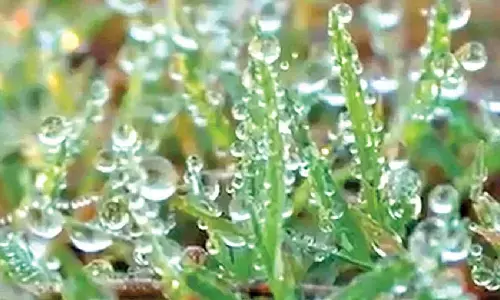Azolla the wonder fern for farming community

At a time, fodder for cattle has become a major problem, Azolla, the aquatic floating fern, is proving to be the perfect solution.
Amalapuram: At a time, fodder for cattle has become a major problem, Azolla, the aquatic floating fern, is proving to be the perfect solution. Moreover, this fern is serving as nutrient to the paddy field. It would help the farmer achieve high yield of milk at the same time solving the problem of green fodder for the cattle.
Dry Azolla flakes can be used as poultry feed and green Azolla is also a good feed for fish. It can be used as a bio-fertilizer, a mosquito repellent, in the preparation of salads and above all as a bio-scavenger as it takes away all heavy metals. Several farmers of Bendamur Lanka in Allavaram mandal in East Godavari district have been growing this fern to solve the fodder problem. AP Livestock Development Corporation chief Yalla Dora Babu is personally growing Azolla at Bendamur Lanka to set an example for the farmers of the district.
The major problem of the cattle rearing community faces is the expensive green fodder for cattle. The problem with the dry grass is that it is less nutrient and there is the danger of pesticide residue present in it. Azolla can be grown in the backyard or the courtyard with minimum expenditure. The farmer can also prepare the fodder plot on his own. Setting up of Azolla fodder plot does not require expertise and the farmer can handle it with ease. If set up in backyard, the area should be leveled and lined with bricks. The side of the plots should be raised to enable the water to stand.
Alternatively, the fodder plot can be in a pit with depth of 0.2 m. A polythene sheet is spread over the bed in such a way that 10 cm of standing water can be maintained. Width of the bed is maintained at 1.5 m to enable the culture preparation from both sides. Length may be varied depending upon the fodder requirement of the unit. For two cows, two units of beds of length 2.5 m each with an area of around 8 sq m can meet 50 per cent of the green fodder requirements.
Once the bed of size 2.5m x 1.5m is ready, about 15 kg of fine sieved soil is spread over the bed, which will provide nutrient to the Azolla plant. About 5 kg of pre-decomposed or 2-day old cow dung is mixed with the water, which provides carbon source for the Azolla. About 40 grams of nutrient mix (made by mixing 10 kg Rock phosphate, 1.5 kg Magnesium salt and 500 g of Murate of potash is added to the Azolla bed.
The solution is fortified with micronutrient of desired quantity. This not only takes care of the micronutrient requirement of Azolla but also the cattle when it is fed with this fern. Sufficient water is added to make the water level of the bed to 10 cm. Production of Azolla scientifically and on a continuous basis requires cement concrete tanks of size 2 m long, 1 m wide and 0.5 m deep.
Due care should be taken so that water can stand in the tank. Ten or more tanks can be constructed in one place covering an area of 25 sq. m. Arrangements for water in each tank should be made by laying pipe and tap from the over head tank. Soil is distributed evenly across the bottom of the tank. The depth of soil layer should be about 10 cm. Cow dung is to be added at the rate of 1 to 1.5 kg per sq m of the tank area (2 to 3 kg of cow dung per tank).
Single Super Phosphate (SSP) is to be added at the rate of 5 g per sq m of the tank area every week. Water should be filled to a height of 10 to 15 cm above the soil. The soil particle should be allowed to settle down. Fresh Azolla inoculum should be prepared by adding 2 g of carbofuran to prevent pest infestation. The layer of foam and scum that forms on the surface of the water should be removed.
The foam impedes the growth and root penetration of Azolla. Allow the tank to stand overnight. On the following day, spread around 200 g of fresh Azolla inoculum over the surface of the water. It takes about 2 weeks for Azolla to form a mat over the water surface. Water level in the tank should be maintained especially during summer months. To reduce excessive ambient light, a shade made out of coconut leaves may be laid above the tank.
This also prevents dew formation on the growing Azolla during winter. About 1.5 kg of mother culture of Azolla seed material brought from Azolla mother nursery is spread uniformly over the bed after stirring the water in the Azolla bed. Care should be taken about the source of the Azolla seed. Azolla, if grown for fodder is essentially required to be grown in hygienic environment and there should be regular supply throughout the year. The fodder plots should preferably be near the homestead, where the female member of the farmer family can attend to nurturing and maintenance.
Azolla also serves as green manure for the paddy field. As green manure, Azolla is grown alone for two to three weeks in flooded fields. Afterwards, water is drained out and Azolla fern is incorporated in the field before transplanting of paddy. Otherwise, 4-5 q of fresh Azolla is applied in standing water one week after planting of paddy. Advantages of Azolla are manifold. It easily grows in wild and can grow under controlled condition also.
It can easily be produced in large quantity required as green manure in both the seasons Kharif and Rabi. It can fix atmospheric C02 and nitrogen to form carbohydrates and ammonia respectively and after decomposition it adds available nitrogen for crop uptake and organic carbon content to the soil. The oxygen released due to oxygenic photosynthesis, helps the respiration of root system of the crops as well as other soil microorganisms.
It solubulises Zn, Fe and Mn and make them available to the rice. Azolla suppresses tender weeds such as Chara and Nitella in a paddy field. Azolla releases plant growth regulators and vitamins which enhance the growth of the rice plant. Azolla can be a substitute for chemical nitrogenous fertilizers to a certain extent (20 kg/ha) and it increases the crop yield and quality. It reduces evaporation rate from the irrigated
rice field.
By K V Suryanarayana Murthy




















